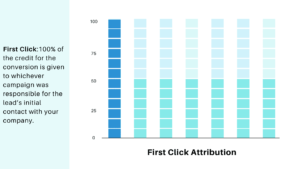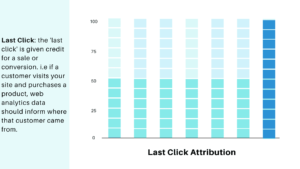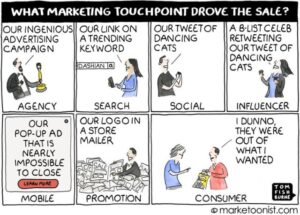Alongside targeting leads, collecting accurate data and scaling, tracking conversions of your campaigns is one of the most important and can be one of the most stressful processes of assessing your campaigns success rate. This is where account based marketing abm attribution comes in.
It can be difficult to track which campaign or digital marketing strategy led to a sale or conversion as there are many factors in play, this is why its important to have an analytic system in place to accurately measure and pinpoint what led to a conversion AKA marketing attribution.
Below we have a breakdown of what Account Based Marketing Attribution is, some examples of attribution models and how they can help you evaluate the success of you marketing efforts.
What is Account Based Marketing Attribution?
Account Based Marketing attribution is the process of measuring the effectiveness of your marketing campaigns. Account based attribution helps identify which campaigns and channels contribute to customer engagement and revenue. This is done by tracking marketing efforts to see which ones are driving customers to make a purchase. It is a way of tracking the impact of various marketing activities and investments on the business and customer conversion rates.
Account Based Marketing attribution tools are used to find out how much revenue was generated from each marketing campaign or sales call. They can also be used to find out which aspects of the campaign are most effective.
The main goal of any attribution campaign is to provide insights into what content lead customers to take an action, for instance, signing up for a website newsletter or downloading an ebook.
One of the most important components in attribution is data quality.
What are Account Based Marketing Attribution models?

Unlike traditional attribution models that target individual leads, ABM attribution evaluates the collective impact of marketing efforts on specific target accounts.
Attribution models are an essential part of modern marketing. Not only are they used to measure campaign success, but also to help understand customer behaviour.
There are many different attribution models that marketers can use when launching campaigns. The three most popular types are last click, first click, and linear.
Linear Attribution Model:

The linear model is the simplest because it assumes that all marketing touchpoints have an equal effect on customer conversion. Analytics tools are essential in tracking these touchpoints and ensuring data accuracy. But in practice this isn’t always true. For example, a banner ad might be very successful in converting prospects to leads, but not so much in converting leads to customers.
First Click Attribution Model:

The first click model assigns 100% of credit for the conversion to whichever campaign was responsible for the lead’s initial contact with your company. Understanding the customer journey is crucial in identifying this initial touchpoint. In other words, if someone clicks through one of your ads, you get full credit for their conversion. If they visit another page within your site before making a purchase, then you don’t receive any credit at all.
Last Click Attribution Model:

This method takes into account every single interaction between a prospect and your brand. Effective data integration from various channels is crucial for accurate attribution. When using the last-click approach, you assign credit for conversions back to the original source of traffic. For example, if a customer orders a product from visiting your site, analytic data should reveal how the customer accessed your site.
We use these attribution models because traditional marketing methods are often problematic in that they can’t be measured, they are too complex to measure, or they are too time-consuming to measure.
Why is Attribution Important in ABM
Traditional attribution models are still important in understanding the purchasing process of customers. Optimizing account based marketing efforts and aligning marketing and sales teams can enhance overall effectiveness. When practising ABM, this consists of following customer interactions with a brand throughout their entire journey via channels including web, mobile, e-mail etc. It is more focused on digital channels and it has two main advantages over traditional attribution models:
- It enables marketers to identify specific audiences who have converted before the customer making the purchase
- It provides insights into how campaigns drive purchases
Account Based Marketing attribution is all about using data to determine how successful your campaign was against multiple touchpoints but to avoid wasting time and resources on data and attribution models make sure you have a strong foundation in place complete with intentions and set goals across both sales and marketing teams for a robust marketing strategy.
The first step towards implementing an effective ABM strategy is identifying your target audience. The next step is to segment them by using data from multiple sources such as social media analytics, website traffic analysis, CRM data etc. Once you know which segments you want to focus on, you can start building out different types of content that will appeal to these groups.
What Is the Attribution Problem in Account-Based Marketing
There are many challenges with Account-Based Marketing attribution, one being that many marketers are not skilled in data analytics and are unable to identify which customer touchpoint led to the conversion. Integrating a marketing automation platform can help consolidate data and provide a comprehensive view of target accounts. Another challenge is that it is difficult to attribute credit for an interaction that spans multiple channels (i.e., email, phone, chat, social). Lastly, there’s no industry-wide standard for identifying the attribution path.
This problem can be resolved by incorporating AI attribution software into your abm campaigns. AI attribution is an algorithmic service that is used to credit touchpoints that led to a conversion. It provides a way of measuring marketing effectiveness across different channels whilst offering insights on what needs to be done differently in order to improve performance. In this way marketers are able to easily track conversion paths across multiple channels.






